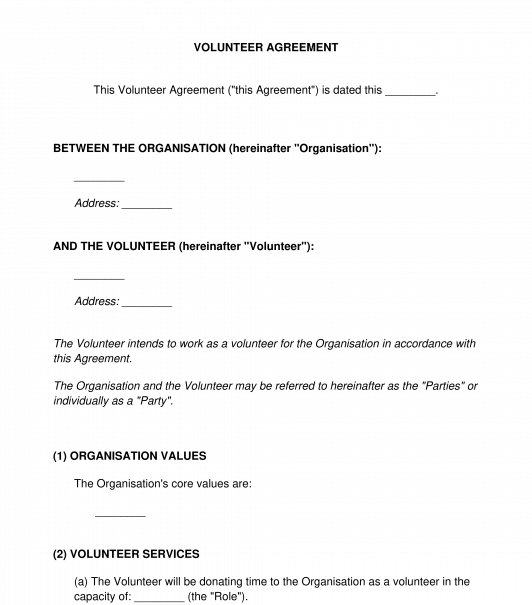 27/01/2025
27/01/2025

Answer a few questions and your document is created automatically.

Your document is ready! You will receive it in Word and PDF formats. You will be able to modify it.

 27/01/2025
27/01/2025
 Word and PDF
Word and PDF
 7 to 10 pages
7 to 10 pages
A Volunteer Agreement is a document that can be used by an organisation that wishes to engage volunteers. Many non-profits that undertake community service work rely on volunteers, as their funding can be limited. Some businesses also take volunteers for internships or vocational placements so that the volunteer can learn about the business and industry.
A good Volunteer Agreement should outline the details of the relationship between the parties and should include a release of liability that is acknowledged by the volunteer. It will also include an indemnification provision for each party.
This document should not be used for hiring an employee. It is only valid in the case of volunteer service. For hiring employees, consider using our Employment Agreement, Letter of Offer of Employment, or Remote Work Agreement.
In Australia, organisations may be permitted to engage volunteers for a number of reasons. This may include:
The Fair Work Commission provides further information. Organisations will need to be careful to make sure they are able to legally engage volunteers. If they do not have a lawful basis which allows them to engage volunteers, then they may be required to treat the person as an employee. This would mean the organisation has to provide minimum employee entitlements such as the minimum wage, superannuation, paid leave, and other similar entitlements as set out in the National Employment Standards. If in doubt, they should seek legal advice.
While volunteering is often a relatively simple arrangement between the organisation and the volunteer, there are some important issues to think about, and for the volunteer to be made aware of. For example:
This Volunteer Agreement addresses many of these issues. However, if in doubt, the parties should seek legal advice.
How to use this document
This document can be used by an organisation that is using volunteers.
Identifying information about the volunteer and the organisation will be entered, as well as the title of the volunteer's role and what specific volunteer services they will be providing. If the organisation wishes to reimburse the volunteer for certain expenses, they can. Then some additional information will be entered, such as the name of the volunteer supervisor and an emergency contact.
When this document is filled out, it should be printed and signed. It can be signed by both the volunteer and the organisation, or by just the volunteer (and not by the organisation). Each party should ideally keep a copy.
Applicable law
Volunteering and Volunteer Agreements in Australia are subject to both federal laws and specific state/territory laws.
The Fair Work Act 2009 (Commonwealth) also deals with unpaid work and says whether an employment relationship exists (in which case the organisation would be obliged to pay the worker) or whether the arrangement involves a vocational placement.
Workplace health and safety legislation in each state and territory may also apply to the organisation, even if it is engaging volunteers and not employees. This means the organisation will need to be aware of its obligations under this workplace health and safety legislation, and will need to make sure to comply with it (for example, by providing a safe working environment).
If in doubt, seek legal advice.
How to modify the template
You fill out a form. The document is created before your eyes as you respond to the questions.
At the end, you receive it in Word and PDF formats. You can modify it and reuse it.
A guide to help you: What to do after Preparing a Contract
Volunteer Agreement - sample template - Word and PDF
Country: Australia